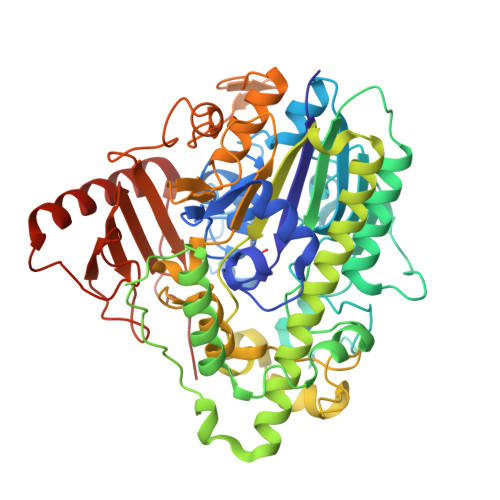Evolutionary repurposing of a sulfatase: A new Michaelis complex leads to efficient transition state charge offset.
Miton, C.M., Jonas, S., Fischer, G., Duarte, F., Mohamed, M.F., van Loo, B., Kintses, B., Kamerlin, S.C.L., Tokuriki, N., Hyvonen, M., Hollfelder, F.(2018) Proc Natl Acad Sci U S A 115: E7293-E7302
- PubMed: 30012610
- DOI: https://doi.org/10.1073/pnas.1607817115
- Primary Citation of Related Structures:
4CXK, 4CXS, 4CXU, 4CYR, 4CYS, 5AJ9 - PubMed Abstract:
The recruitment and evolutionary optimization of promiscuous enzymes is key to the rapid adaptation of organisms to changing environments. Our understanding of the precise mechanisms underlying enzyme repurposing is, however, limited: What are the active-site features that enable the molecular recognition of multiple substrates with contrasting catalytic requirements? To gain insights into the molecular determinants of adaptation in promiscuous enzymes, we performed the laboratory evolution of an arylsulfatase to improve its initially weak phenylphosphonate hydrolase activity. The evolutionary trajectory led to a 100,000-fold enhancement of phenylphosphonate hydrolysis, while the native sulfate and promiscuous phosphate mono- and diester hydrolyses were only marginally affected (≤50-fold). Structural, kinetic, and in silico characterizations of the evolutionary intermediates revealed that two key mutations, T50A and M72V, locally reshaped the active site, improving access to the catalytic machinery for the phosphonate. Measured transition state (TS) charge changes along the trajectory suggest the creation of a new Michaelis complex (E•S, enzyme-substrate), with enhanced leaving group stabilization in the TS for the promiscuous phosphonate ( β leaving group from -1.08 to -0.42). Rather than altering the catalytic machinery, evolutionary repurposing was achieved by fine-tuning the molecular recognition of the phosphonate in the Michaelis complex, and by extension, also in the TS. This molecular scenario constitutes a mechanistic alternative to adaptation solely based on enzyme flexibility and conformational selection. Instead, rapid functional transitions between distinct chemical reactions rely on the high reactivity of permissive active-site architectures that allow multiple substrate binding modes.
Organizational Affiliation:
Department of Biochemistry, University of Cambridge, CB2 1GA Cambridge, United Kingdom.



















